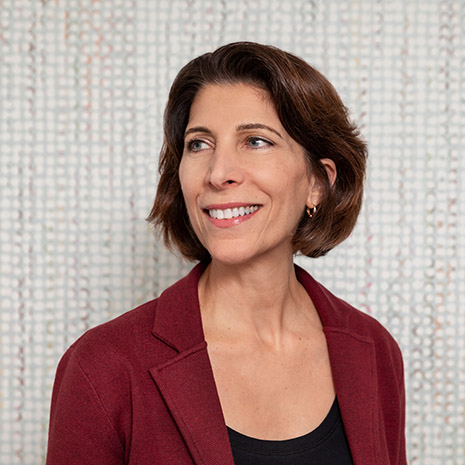COM, Katzenberg, and Spielberg Embrace Short-Form Videos

With Hollywood embracing short-form video, the College of Communication is following suit. In 2020, Paul Schneider and Debbie Danielpour will teach Developing the Short Film or Short-Form Series for the first time. Photo by Dan Watkins
COM, Katzenberg, and Spielberg Embrace Short-Form Videos
Why the future of television is in your pocket
In the first episode of the quirky Netflix series Love, Death & Robots, three animated robots roam a post-apocalyptic Earth examining the remains of human society. “What’s the point of this thing?” one of them asks when they see a cat. “They had an entire network that was devoted to the dissemination of pictures of these things,” another replies. The distribution of silly cat videos may not rank as the internet’s top contribution to civilization, yet it’s an iconic representation of a trend set to reach new heights in 2020: short-form video. Film and television creators, from the College of Communication to Hollywood, are betting big on a form of programming that not only breaks free from the constraints of broadcast television, but competes with the likes of YouTube, Instagram, and TikTok.
Short-form programs can tell fiction or nonfiction stories, they can stand alone or arc a story across a season, but they do so in tiny bites. Season one of the Emmy-winning Love, Death & Robots includes 18 stand-alone episodes. They range in length from 6 to 17 minutes and can be watched in any order. If binge-watching a traditional television show is like reading a novel, watching this short-form anthology is akin to flipping through a magazine. Netflix also offers more traditional comedy and drama shows in short-form packages, including Special, the story of a gay man with cerebral palsy. HBO picked up the independent production High Maintenance, about a marijuana dealer. Topic, the studio behind the Oscar-winning feature film Spotlight produces a range of nonfiction short-form, including the quirky Birds of North America, which follows its host on bird-watching excursions in Central Park. You could watch an episode of any of them during your commute—or binge on an entire season in an evening.
The biggest development—and test—for this format comes in April, with the launch of Quibi, a platform that will offer nothing but original short-form programming designed specifically for smartphone viewing. The company—its name is short for “quick bites”—has reportedly raised $1 billion in funding, sold $100 million in advertising and has projects in development from Steven Spielberg (Hon.’09), Lorne Michaels, Jennifer Lopez, and many others. COM is paying attention: in a few weeks, Paul Schneider, professor of the practice, film and television, and department chair, and Debbie Danielpour, an assistant professor of film, will launch a new course, Developing the Short Film or Short-Form Series.
An Academic Opportunity
For filmmakers accustomed to creating work that will be projected onto a 50-foot-wide screen, or even a 50-inch television, the idea of an image that’s 5 inches wide requires a big adjustment. But for Schneider and Danielpour, the growing interest in short-form video means more opportunities for their students.

“There’s never been a period in history where there’s so much demand for story content,” says Schneider. “There’s never been such an explosion of content formats.” Those enrolled in their new course will learn to pitch ideas and develop scripts for a short program or the pilot episode of a series. Danielpour and Schneider will help them find the delicate balance between telling compelling stories and the limits of the form. “Simplicity is usually a good thing,” Schneider says. “And you have to hook people early on.”
“Storytelling has some fundamental commonalities,” says Danielpour. Whether it’s a 2-hour movie or a 10-minute short, it will usually have characters, a problem, and ultimately, closure. But the limits of short-form demand some concessions. Even a 30-minute sitcom might have space to weave its storyline and multiple subplots together, but a shorter program needs to be streamlined. “The pacing is going to be a little faster and your scenes are going to be a little shorter,” she says. “Compression is the answer—and that’s why screenwriters get the big bucks.”
Viewers’ migration to smaller screens imposes visual constraints as well. “It’s not going to be Close Encounters of the Third Kind, where you’re dependent on huge visuals,” Schneider says. “It’s a more intimate situation [watching on a phone]. It’s probably going to be more character-based.”
Even within the constraints of time and screen size, Danielpour sees an opportunity for creativity—and has high hopes that filmmakers will begin to experiment more with dramas in a field thus far dominated by comedy. “We’re no longer hemmed in by the 30-minute and one-hour time slots,” she says of the break from broadcast television. “And we’re in this cool nascent phase of this form. Hopefully, we can elevate it a little bit.”
Ultimately, the two professors want the scripts developed in the spring to be available for students in COM’s film production courses next year. “And hopefully we’ll stick them on the web and maybe something will get discovered and someone at HBO will pick it up,” Danielpour says with a smile.
Hollywood Meets Silicon Valley
Audiences are already streaming huge amounts of video, many on their smartphones, and some of entertainment’s biggest names are hoping to capture that audience. HBO and Disney recently released high-profile subscription-based services offering extensive libraries of classic shows and movies alongside original productions; CBS, NBC, and others have or are planning their own such services. In April, the launch of Quibi—headed by former Walt Disney chair and DreamWorks cofounder Jeffrey Katzenberg, and former Hewlett Packard and eBay CEO Meg Whitman—will test consumers’ appetite for short-form.
“You have two and a half billion people walking around with these televisions in their pockets. They’re already watching a billion hours of content every day. I just know it’s going to work.”
For a monthly fee—$4.99 with ads, $7.99 without—subscribers will have access to a range of short-form programs through the company’s app. It’s a bit like cable TV in miniature, offering news and sports highlights, soap operas, game shows, comedy and drama. ESPN will provide a sports highlight show. NBC is producing news. Steven Spielberg was inspired to write a script for the first time in nearly two decades, for a horror show that will take advantage of a phone’s location data and play only at night. A slate of other Hollywood stars are working on shows of every imaginable genre.
Unlike most streaming services, Quibi is targeting phones specifically, hoping to capitalize on the time people spend away from their televisions. And that’s a huge audience: in research performed by Common Sense Media, watching online videos is now the number one media activity for tweens, shooting past television, video games, and music in just five years. In an interview with Forbes, Katzenberg cited YouTube’s two billion monthly users. “Some small percentage of that universe of several billion people I think are going to migrate to super premium, high-quality, Hollywood-level production and storytelling,” he said.
Whitman says Quibi is aiming to capture “in-between moments”: when you’re commuting, standing in line at the coffee shop, or sitting at the doctor’s office. “You have two and a half billion people walking around with these televisions in their pockets. They’re already watching a billion hours of content every day. I just know it’s going to work,” said Katzenberg (the parent of two COM alums and a former BU trustee) on CNN in March.
Those viewing habits represent a tidal shift that could create opportunities for projects that in the recent past weren’t considered viable. The creators of Love, Death & Robots, Tim Miller (director of Deadpool) and David Fincher (director of The Social Network), began talking about their project about 10 years ago, but didn’t find funding until they approached Netflix. In that decade, viewing habits had changed. “It’s funny, because David and I back then would be having the argument of, ‘Can people consume media this way?’ And now it becomes the argument of, ‘Can people consume media any other way?’” Miller said to IGN, a gaming and entertainment site.
Whether there’s an appetite for high-quality video and whether viewers will pay a monthly subscription fee are two separate questions. “The business model is evolving before our eyes—this is the most volatile time,” Schneider says. But, he adds, “there’s no question that if people turn out good material, because of the vast audience on cell phones, this will be sustainable.” What Quibi, or the industry at large, needs is for someone to produce a must-see short-form program—a Game of Thrones for the medium.
But Quibi isn’t the first company to try this. In one high-profile attempt, Verizon launched go90—a video service aimed at smartphone viewers—in 2015, investing more than $1 billion in the project over three years. A reportedly unfocused business plan led to its demise in 2018.

Alejandra Del Real (COM’09) was an executive at the French video production company Blackpills when it made its foray into short-form video in 2017. Del Real, who has since moved on to a creative agency in London, says the shorter production times and lower costs created opportunities for new artists, and the format was liberating for viewers as well. “If you binge-watch it, it’s like watching a feature film,” she says. “But if you don’t, then you get a complete, kind of condensed, compelling story with no decoration, no frills.”
At Blackpills, which had aimed to release a high-end short-form show every week on a subscription-based app, the effort to generate enough content proved unsustainable and they shut down the app. The company now focuses on production as a more traditional studio and recently sold a short-form production, Bonding, to Netflix. Del Real has reservations about the Quibi approach. “I stand completely by the format,” she says. “But I question very heavily whether there’s a need to have a dedicated platform. Maybe Jeffrey Katzenberg will prove me wrong.”
Schneider compares this moment to an earlier era of cable television. “There wasn’t that much to jump up and down about,” he says. “But then HBO made The Sopranos and AMC made Mad Men.” Those shows elevated the form and launched a golden age of television. Whether the same can be done with short-form remains to be seen. “The doors are about to open,” he says. “We don’t know yet where it’s all going to go.”
Comments & Discussion
Boston University moderates comments to facilitate an informed, substantive, civil conversation. Abusive, profane, self-promotional, misleading, incoherent or off-topic comments will be rejected. Moderators are staffed during regular business hours (EST) and can only accept comments written in English. Statistics or facts must include a citation or a link to the citation.